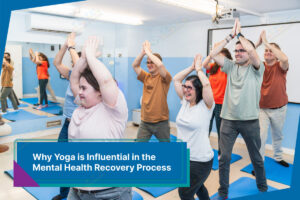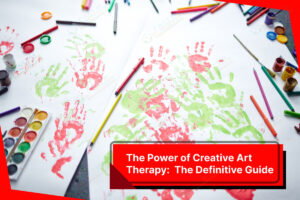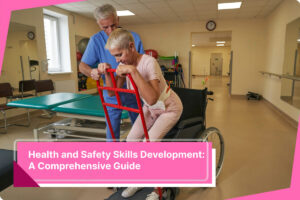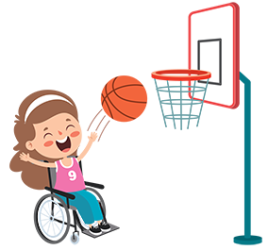Recovery (addiction, trauma, illness) is not only the process of repairing what has been broken. It is connected to finding balance and harmony again. Although therapy, medicine, and counseling are considered significant, yoga has become one of the holistic methods of curing the body and mind.
All over the globe, several individuals refer to a yoga therapy center mentally or physically disabled people helps them in their healing process. Yoga produces an alternative experience of mindfulness and self-compassion through movement, breath, and mindfulness, accelerating the healing process.
Now we would like to discuss the process of healing, why yoga is so effective and why it is so powerful as a tool of recovery.
What Makes Yoga Different From Regular Exercise?
Yoga does not merely involve physical exercise, but it is more of a discipline that unites your body, mind, and feelings. Yoga is not about performance, as is the case with most workouts.
At a yoga therapy center, every session will aim at:
- Build strength gently without strain
- Encourage mindfulness and self-observation
- Regulate breathing to calm the nervous system
- Support both physical and emotional healing
How Does Yoga Help the Body Heal?
Physical restoration can begin with the restoration of strength, flexibility and stability. Yoga provides easy but efficient exercises that enhance the flow of blood, eliminate stiffness, and lessen pain.
Here’s how yoga supports physical healing:
- Improves blood flow: Enhances oxygen supply to tissues and speeds up repair.
- Reduces inflammation: Certain postures promote detoxification.
- Boosts immunity: Helps regulate body systems for better resistance.
- Relieves tension: Eases muscle tightness caused by stress or trauma.
In the long run, yoga replenishes the balance between strain and relaxation, which is an essential part of a recovery that is sustainable.
Why Is Breath So Important in Recovery?
The body and mind are united through breathing. When we are under stress, we breathe shallowly, and this is a warning to the brain. Yoga retrains this pattern.
In a yoga therapy center, you will learn breathing exercises (so-called pranayama) which will enable you to:
- Calm anxiety and reduce panic attacks
- Improve sleep and relaxation
- Balance emotions through oxygen flow
- Develop awareness of inner sensations
Can Yoga Really Help With Emotional Healing?
Yes, absolutely. Yoga has so many gifts to give us, and emotional recovery is one of them. Unprocessed emotions such as grief, anger, and shame are trapped in the bodies of many people. Yoga assists in the release of them in a safe way.
You are taught to watch the emotions without judging them through gentle movement, breathing, and meditation. In the long run, this resilience and emotional intelligence are developed.
Yoga encourages:
- Self-acceptance: Letting go of guilt and fear
- Emotional stability: Learning to stay calm during ups and downs
- Inner peace: Creating space for forgiveness and healing
Teachers at a yoga therapy center can be helpful in taking you through restorative poses and even relaxation exercises which aid in healing emotional wounds and restoring self trust.
How Does Yoga Rebuild the Mind-Body Connection?
Individuals are normally disconnected with their bodies when they are traumatized, addicted or under stress. Yoga helps to make you aware of yourself.
When you start to be mindful of your movements and breath, you start to notice:
- Where tension or pain lives in your body
- How emotions show up physically
- What sensations indicate stress or calm
This body consciousness will give you the power to react, rather than to act reactively. That is why a lot of recovery programs incorporate yoga therapy in a comprehensive healing program.
Can Yoga Help Overcome Addiction and Cravings?
Yoga is indeed very effective in the recovery of addiction. Addiction in most cases is a result of attempting to avoid pain or a feeling of discomfort. Yoga shows the contrary, to be present, breathe and observe without judgment.
Here’s how yoga helps with addiction recovery:
- Reduces cravings: Breathing exercises calm the brain’s stress center.
- Releases dopamine naturally: Movement and meditation restore reward balance.
- Teaches patience: You learn to sit with difficult emotions.
- Encourages mindfulness: Helps identify triggers before relapse.
There is a large number of yoga therapy facilities cooperating with rehabilitation facilities, where specific yoga practice sessions are provided to facilitate the detox process and avoid relapse with the help of inner awareness.
What Role Does Yoga Play in Building Confidence?
After recovery, self-doubt and lack of confidence usually come with it. That confidence can be restored by yoga, pose by pose.
Whenever you balance further or even reach further, you are reminded that progress can be made. The practice glorifies small successes, and they add up to the restoration of belief in yourself.
Within a yoga therapy studio, teachers promote post-practice reflection in the form of journaling, experience sharing, or noting the change. The self-esteem and future expectations are fostered by these conscious experiences.
How Does Yoga Support Mental Clarity and Focus?
In the recovery process, individuals tend to have brain fog, loss of motivation or racing thoughts. Yoga clears that clutter.
Through the process of meditation and conscious breathing you condition your mind to be present. This enhances concentration, memory as well as lessening over thinking.
Benefits include:
- Improved attention span
- Better decision-making
- Reduced mental fatigue
- Greater emotional control
Regular attendance at a yoga therapy center aids in the development of mental disciplines, which aid in long-term recovery and stability of lifestyle.
What Kind of Yoga Is Best for Recovery?
Yoga is not identical in all the styles. Light, recuperating and meditative exercises are most effective in recovery.
The following are some of the common methods:
- Restorative Yoga: Uses props for deep relaxation
- Hatha Yoga: Focuses on slow, steady poses and breathing
- Yin Yoga: Involves long-held stretches that release tension
- Trauma-Sensitive Yoga: Adapts movements to create a sense of safety
A certified yoga therapy center will create training programs with references to the individual needs, such as chronic pain, addiction, depression and post-traumatic recovery training.
How Does Yoga Complement Other Therapies?
Yoga doesn’t replace medical or psychological treatments — it enhances them. When combined with therapy, medication, or counseling, yoga helps create a complete healing system.
For instance:
- Someone in physiotherapy can use yoga to improve mobility
- A person in trauma therapy can use yoga to release physical stress
- Individuals on medication can use breathing to manage side effects
Why Do People Feel a Sense of Belonging in Yoga?
Recovery can feel lonely. But yoga brings people together. Practicing alongside others who share similar experiences builds connection and understanding.
At a yoga therapy center, this sense of community can:
- Reduce isolation and loneliness
- Provide encouragement and accountability
- Offer emotional support and friendship
Conclusion
Recovery is not only a matter of pain, overcoming it is a matter of rebuilding wholeness. Yoga can make you re-in touch with your body, relax your mind and open your heart to healing.
It doesn’t matter if you are getting over an addiction or trauma or simply overcoming a physical difficulty, a yoga therapy center provides the framework and encouragement you require to change profoundly.
Yoga is a lifestyle through practice, and it is not a routine. It is a lesson to breathe despite the pain, have faith in your strength, and be at peace with the moment.
Ultimately, yoga is not only a way to heal, it is a way to find yourself again.













